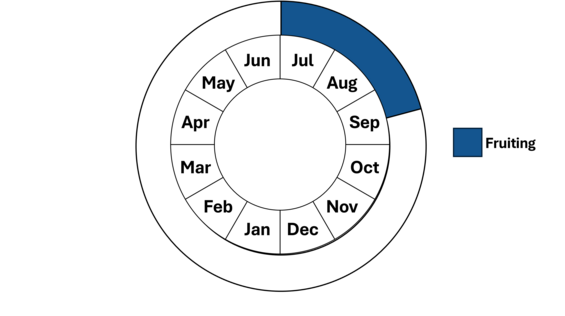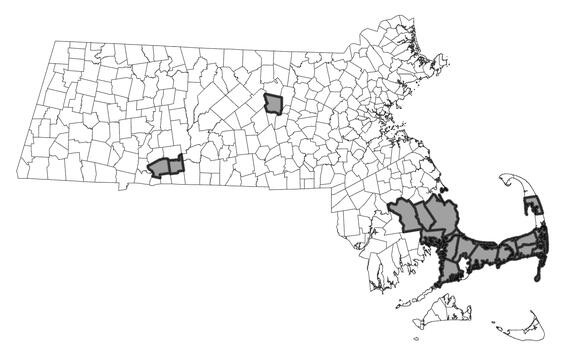- Scientific name: Sagittaria teres S.Watson
- Species of Greatest Conservation Need (MA State Wildlife Action Plan)
- Special Concern (MA Endangered Species Act)
Description
Terete arrowhead (Sagittaria teres) is a perennial emergent aquatic plant of the water-plantain family (Alismataceae), which grows in shallow water along the margins of coastal plain ponds. It has linear basal leaves and white flowers, which bloom from July to September.
Terete arrowhead, unlike several other arrowheads, has linear, terete (rounded in cross section), and tapering leaves rather than sagittate, or arrow-shaped leaves. The leaves arise from a rhizome in a rosette; they vary in length, ranging from 3-20 cm (1.2-8 in). The stem is erect, slender, and leafless, reaching 30-38 cm (12-15 in) in height. The flowers, which have white petals and yellow centers, are 2 cm (0.75 in) wide, and are borne in two to four whorls at the top of the stem. Fruits of this species are achenes (hard, one-seeded fruits), less than 2-3 mm (0.1 in), with one to three prominent wings on each face.
Most arrowheads in Massachusetts have some sagittate leaves present, thus differentiating them from terete arrowhead. One other state-listed species, river arrowhead (S. Subulata; Endangered), and the more common grass-leaved arrowhead (S. graminea) most resemble terete arrowhead because of their linear, unlobed leaves. Both of these species however have flat, rather than terete leaves.
Life cycle and behavior
This is a perennial species.

Population status
Terete arrowhead is listed under the Massachusetts Endangered Species Act as a species of Special Concern. All listed species are legally protected from killing, collection, possession, or sale, and from activities that would destroy habitat and thus directly or indirectly cause mortality or disrupt critical behaviors. Terete arrowhead is currently known from Barnstable, Plymouth, Hampden, and Worcester Counties, and is historically known from Middlesex County.
Distribution and abundance
Terete arrowhead, a globally rare species, is only found in New Hampshire, Massachusetts, New York and New Jersey. It is critically imperiled in all but Massachusetts where it is assessed as vulnerable (NatureServe 2025).

Distribution in Massachusetts
1999-2024
Based on records in the Natural Heritage Database
Habitat
In Massachusetts, terete arrowhead inhabits muddy, sandy, or peaty soils in shallow water along the margins of acidic ponds, primarily coastal plain ponds. Associated species include pipewort (Eriocaulon aquaticum), water-lobelia (Lobelia dortmanna), bladderworts (Utricularia spp.), golden hedge-hyssop (Gratiola aurea), pond-shore rush (Juncus pelocarpus), and spike-sedges (Eleocharis spp). Several rare species may be associated with terete arrowhead, including resupinate bladderwort (Utricularia resupinata; Threatened), Plymouth gentian (Sabatia kennedyana; Special Concern), Torrey’s beak-sedge (Rhynchospora torreyana; Endangered), long-beaked bald-sedge (R. Scirpoides; Special Concern), and short-beaked bald-sedge (R. Nitens; Threatened).
Healthy habitats are vital for supporting native wildlife and plants. Explore habitats and learn about conservation and restoration in Massachusetts.
Threats
Terete arrowhead is threatened by any activity that changes the hydrologic regime, water quality, or soil integrity of the coastal plain pond it inhabits. Region-wide, coastal plain ponds are imperiled due to shoreline development, water table drawdown (from wells), eutrophication (resulting from fertilizers and septic systems), and soil disturbance from heavy recreational use (ORV, horse, and foot traffic; wading and swimming; camping; boat-launching; raking and digging).
Conservation
Management of terete arrowhead requires protection of the hydrology, water quality, and soil integrity of its habitat. Like many other coastal plain pondshore plant species, terete arrowhead requires pronounced water-level fluctuations, acidic, nutrient-poor water and substrate, and an open, exposed shoreline, free from major soil disturbance.
Terete arrowhead populations should be monitored regularly to identify possible threats. This species is most likely to be observed in mid to late summer during low water years. Protection of terete arrowhead habitat may require the exclusion of new wells and septic systems, prohibitions on fertilizer use, and restrictions on recreational use of the coastal plain pond shore. Recreational activities such as swimming, fishing, and boat-launching should be diverted from the plant population location by providing alternative locations for the activities.
Also, habitat sites should be monitored to enable early detection of exotic plant species invasions. The nature of coastal plain ponds makes them generally inhospitable for many exotic invasive plants, but invasives could become established at sites that have received heavy soil disturbance or nutrient inputs. Exotic species that could establish along the shoreline of coastal plain ponds include Common Reed (Phragmites australis ssp. australis), Gray Willow (Salix cinerea), and Purple Loosestrife (Lythrum salicaria).
Boats are a very common vehicle for aquatic plant introductions, and habitat sites with boat access should be carefully monitored for introductions of non-native aquatic species, such variable water-milfoil (Myriophyllum heterophyllum) and inflated bladderwort (Utricularia inflata).
To avoid inadvertent harm to rare plants, all active management of rare plant populations (including exotic species removal) should be planned in consultation with the Massachusetts Natural Heritage and Endangered Species Program.
References
Crow, G.E. and C.B. Hellquist. Aquatic and Wetland Plants of Northeastern North America. Volume Two Angiosperms: Monocotyledons. 2000. The University of Wisconsin Press. Madison Wisconsin.
Haines, A. 2011. Flora Novae Angliae – a Manual for the Identification of Native and Naturalized Higher Vascular Plants of New England. New England Wildflower Society, Yale Univ. Press, New Haven, CT.
NatureServe. 2025. NatureServe Network Biodiversity Location Data accessed through NatureServe Explorer [web application]. NatureServe, Arlington, Virginia. Available https://explorer.natureserve.org/. Accessed: 5/27/2025.
POWO (2025). Plants of the World Online. Facilitated by the Royal Botanic Gardens, Kew. Published on the Internet; https://powo.science.kew.org/ Accessed: 5/27/2025.
Contact
| Date published: | May 8, 2025 |
|---|